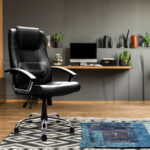This post contains affiliate links, and we will be compensated if you buy after clicking on our links.
Choosing the right chair is essential for maintaining good posture and preventing discomfort during long hours of sitting, whether it be at a desk, computer, or conference room.
When it comes to selecting the appropriate chair, one of the main considerations is the backrest height. Mid-back and high-back chairs are two popular options, each with its own set of advantages and disadvantages.
In this article, we will compare and contrast mid-back vs. high-back chairs to help you make an informed decision on which one is right for your needs.

Key Differences
The most significant difference between mid-back and high-back chairs is the height of the backrest. A mid-back chair typically has a backrest that reaches the middle of your back, while a high-back chair has a backrest that extends above your shoulders.
This means that high-back chairs provide more support for your neck and upper back, while mid-back chairs are better suited for those who don’t require as much upper-back support.
Another key difference is the style of the chair. High-back chairs tend to have a more executive look and are often made of leather or other high-end materials.
Mid-back chairs, on the other hand, are more versatile and come in a range of styles, from basic mesh chairs to ergonomic designs.

What is a mid-back chair?
A mid-back chair is a type of office or desk chair that provides support for the middle region of the back, specifically targeting the lumbar and thoracic regions. These chairs typically have a backrest that extends up to the shoulder blade area, offering support and comfort to the user.
Mid-back chairs are designed to encourage good posture and reduce strain on the lower and middle back muscles during long periods of sitting.
They often come with various adjustment features such as seat height, tilt, and armrests to cater to individual preferences and body types.
While mid-back chairs offer decent support for the back, they do not provide full support for the upper back, neck, and head, as high-back chairs do.
Therefore, they are more suitable for individuals who do not require extensive upper back and neck support or for tasks that involve shorter sitting durations.
Benefits of Using a Mid-back Chair
- More versatile in terms of style and design
- Often less expensive than high-back chairs
- Easier to move around and store.
- Suitable for those who don’t require a lot of upper back support.
Disadvantages of Mid Back Chair
- Limited Upper Back and Neck Support: As mentioned earlier, mid-back chairs do not provide as much support for the neck and upper back as high-back chairs. This can be a disadvantage for individuals who require extensive support in those areas.
- Lack of Adjustability: While many mid-back chairs come with adjustable features, some models may not provide enough adjustability to fit the user’s body type or preferred sitting posture.
- Not Suitable for Tall People: Mid-back chairs may not be suitable for tall individuals as the backrest may not be high enough to provide adequate support for the upper back and shoulders.
When Should I Use a Mid Back Office Chair?
- Shorter Sitting Durations: If you only spend a few hours a day sitting at a desk, a mid-back chair can provide adequate support for your lower and middle back without the need for extensive upper back and neck support.
- Limited Budget: If you are on a tight budget, mid-back chairs are often less expensive than high-back chairs, making them a more affordable option.
- Good Posture: If you have good posture and do not require extensive upper back and neck support, a mid-back chair can help you maintain proper alignment and reduce the risk of developing back pain.
- Smaller Workspaces: If you have limited space in your office or workspace, a mid-back chair can be a more compact option than a high-back chair.
- Flexibility: If you need a chair that is versatile and can be used for multiple tasks, a mid-back chair may be suitable as it can provide good support for a range of sitting postures.
It’s worth noting that if you have specific back or neck conditions, it’s always best to consult with a medical professional or ergonomic specialist to determine the best chair for your needs.

What is a High-back Chair?
A high-back chair is a type of office or desk chair that provides extensive support for the entire back, including the upper back, neck, and head.
These chairs typically have a tall backrest that reaches the headrest area, offering enhanced support and comfort to the user.
High-back chairs are designed to promote proper posture and reduce strain on the back, neck, and shoulder muscles during extended periods of sitting. T
hey often come with a variety of adjustment features such as seat height, tilt, armrests, and headrests to accommodate individual preferences and body types.
While high-back chairs offer comprehensive support for the entire back, they may be less versatile in terms of style and design compared to mid-back chairs.
They are more suitable for individuals who require significant upper back and neck support or for tasks that involve longer sitting durations.
Benefits of Using a High-back Chair
- Enhanced Upper Back and Neck Support: High-back chairs provide superior support for the neck and upper back, making them ideal for individuals who require extensive support in those areas.
- Improved Posture: The design of high-back chairs encourages proper posture by providing support for the entire back, reducing the risk of developing back pain and other musculoskeletal issues.
- Increased Comfort: With their tall backrests and additional headrests, high-back chairs offer increased comfort during long periods of sitting.
- Suitable for Tall People: High-back chairs are often better suited for tall individuals as the backrest is high enough to provide adequate support for the upper back and shoulders.

Disadvantages of High-back Chairs
- Less Versatile in Style and Design: High-back chairs may not offer as much variety in terms of style and design compared to mid-back chairs.
- More Expensive: High-back chairs are generally more expensive than mid-back chairs due to their additional features and support.
- Requires More Space: High-back chairs tend to be bulkier and may not be suitable for smaller workspaces or offices.
When Should I Use a High-back Office Chair?
- Longer Sitting Durations: If you spend several hours a day sitting at a desk, a high-back chair can provide comprehensive support for your entire back, neck, and head.
- Upper Back and Neck Support: If you require significant support for your neck and upper back, a high-back chair is more suitable than a mid-back chair.
- Height Considerations: If you are tall or have a long torso, a high-back chair may provide better support and comfort for your upper back and shoulders.
- Specific Conditions: If you have pre-existing back or neck conditions, a high-back chair may be more appropriate as it provides additional support in those areas. It is essential to consult with a medical professional or ergonomic specialist to determine the best chair for your needs.

Which One Should I Choose: Mid-back or High-back Chair?
When deciding between a mid-back and high-back chair, it’s essential to consider your specific needs, preferences, and circumstances. Here are some factors to take into account when making your decision:
- Support Requirements: Evaluate the level of support you need for your back, neck, and head. If you require significant upper back and neck support, a high-back chair may be more suitable. However, if you only need support for your lower and middle back, a mid-back chair should suffice.
- Sitting Duration: Consider how long you typically sit at your desk each day. For extended periods of sitting, a high-back chair is often more appropriate as it provides comprehensive support for your entire back. If you sit for shorter durations, a mid-back chair may be adequate.
- Budget Constraints: Keep in mind that high-back chairs tend to be more expensive than mid-back chairs. If you have a limited budget, you might want to consider a mid-back chair as a more affordable option.
- Workspace Size: Assess the available space in your office or workspace. If you have a smaller area, a mid-back chair may be more suitable due to its compact design. High-back chairs tend to be bulkier and may not fit well in tight spaces.
- Height and Body Type: Consider your height and body type when choosing a chair. Tall individuals or those with long torsos may find high-back chairs more comfortable and supportive. Mid-back chairs may not provide adequate support for the upper back and shoulders of taller users.
- Medical and Ergonomic Considerations: If you have pre-existing back or neck conditions, it’s essential to consult with a medical professional or ergonomic specialist before choosing a chair. They can help you determine which type of chair would best support your needs and minimize the risk of exacerbating your condition.
Ideal Hight Table
| Chair Type | Ideal Height Range |
|---|---|
| Mid-back Chair | 5’0″ – 6’0″ (152 – 183 cm) |
| High-back Chair | 5’8″ – 6’6″ (173 – 198 cm) |

Conclusion
In conclusion, both mid-back and high-back chairs offer different levels of support and comfort for users.
Mid-back chairs are ideal for those who require lower and middle-back support, have limited budgets, or work in smaller spaces.
On the other hand, high-back chairs provide comprehensive support for the entire back, neck, and head, making them suitable for individuals who spend long hours sitting or require significant upper back and neck support.
However, it is important to take into consideration that some premium brands may offer a similar level of support and comfort in their mid-back chairs as high-back chairs from other brands.
These high-quality mid-back chairs can provide a balanced option for users who want the best of both worlds.
When choosing the right chair for your workspace, it is essential to consider factors such as support requirements, sitting duration, budget constraints, workspace size, height and body type, and any medical or ergonomic considerations.
By carefully evaluating these factors, you can make an informed decision and select the most suitable chair for your needs.

FAQ
What is the main difference between a mid-back and a high-back chair?
The main difference between a mid-back and a high-back chair is the level of support provided for the upper back, neck, and head. Mid-back chairs primarily support the lower and middle back, while high-back chairs offer comprehensive support for the entire back, neck, and head.
Which chair is better for upper back and neck support?
High-back chairs are better for upper back and neck support, as they come with taller backrests and often include headrests.
How do I determine the appropriate chair height for my body type?
To determine the appropriate chair height for your body type, consider factors such as your height, torso length, and personal comfort. Trying out different chairs and adjusting the seat height can help you find the best fit.
Can a mid-back chair be suitable for taller individuals?
A mid-back chair may be suitable for taller individuals if it provides adequate support for their lower and middle back. However, high-back chairs are often better suited for taller users, as they offer enhanced support for the upper back and shoulders.









